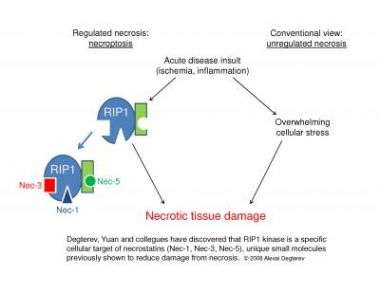Stopping unwanted cell death: Implications for drug discovery

Research published in Nature Chemical Biology reveals that three specific inhibitors of a cell death pathway, termed necroptosis, all target and inhibit RIP1 kinase, a protein that can direct cells into necrosis. Induced by trauma such as a heart attack or stroke, this form of necrotic death can result in tissue damage contributing to death or long-term disability. The findings present a novel avenue for drug development.
“Our research found that RIP1 kinase can be inhibited by three small molecules: necrostatin-1, -3 and -5,” reports first author Alexei Degterev, PhD, assistant professor at Tufts University School of Medicine and member of the biochemistry program faculty of the Sackler School of Graduate Biomedical Sciences. “Overall, these data establish RIP1 kinase as a new target for therapeutic drug development for human diseases involving necrotic tissue injury, and they establish necrostatins as first-in-class potent and selective inhibitors of RIP1 kinase,” the authors write, including last author, Junying Yuan, PhD, professor at Harvard Medical School.
Necrosis is relevant to many diseases, particularly those that involve an acute event, such as heart attack or stroke. “Cells are programmed to die when they reach the end of their lifecycle and that regulated process is called apoptosis. Cells can also be killed through pathways not controlled by apoptosis. Until recently, this type of cell death, termed necrosis, was believed to be unregulated, a type of accidental cell death caused when cells are placed under extreme stress such as during a heart attack, stroke or organ failure,” says Degterev.
Previous research, as well as research by others, determined that necroptosis, one type of necrosis, is regulated (like apoptosis) and has a specific biochemical pathway. “Through our previous work, we have developed potent and specific small molecules capable of preventing necroptosis in isolated cells,” explains Degterev. This work, done in Yuan’s lab at Harvard, was subsequently awarded patents. “The next step, then, was to look for the target of the inhibition by necrostatins to understand how they inhibit necroptosis. We were particularly interested in RIP1 kinase because it was previously reported by other groups to be important for necroptosis and necrostatin-1 looked similar to known kinase inhibitors.”
The researchers employed several molecular techniques to determine the role these necrostatins played in inhibiting necroptosis. To test whether necrostatin-1 is a RIP1 kinase inhibitor in vitro, researchers added necrostatin-1 in incremental doses to purified RIPI kinase, and observed a dose-dependent decrease in its activity (phosphorylation). To validate their discovery, the researchers made small and specific structural changes to necrostatin-1, to see if loss of the RIP1 kinase inhibition resulted in the inability of the necrostatin-1 analogs to prevent necrosis. Similar experiments were conducted for necrostatin-3 and necrostatin-5 with similar results, which was surprising as the structure of these two molecules are very different from necrostatin-1. Further, based on the results of their analysis, researchers put forward the model describing mechanisms of RIP1 inhibition by necrostatin-1.
“Next, research needs to determine the cellular pathway initiated by RIP1 kinase activity, develop better tools to further investigate its role in human disease, and establish how necrostatins are able to prevent RIP1 kinase from signaling the cell to kill itself,” says Degterev. “This may one day result in effective therapies, currently not available, for many life-threatening diseases.”
“These findings on RIP1 kinase inhibitors suggest entirely new possibilities to investigating the role of necroptosis in disease and indicate that these inhibitors may provide ways to prevent extensive tissue damage,” says Naomi Rosenberg, PhD, dean at the Sackler School of Graduate Biomedical Sciences and vice dean for research at Tufts University School of Medicine. “Discoveries like this reveal how basic science research provides the foundation to our understanding of disease and can point toward possible novel therapeutic strategies to ease the burden of those diseases.”
Citation: Degterev A, Hitomi J, Germscheid M, Ch’en IL, Korkina O, Teng X, Abbott D, Cuny GD, Yuan C, Wagner G, Hedrick SM, Gerber SA, Lugovskoy A, Yuan J. Nature Chemical Biology. 2008 (May);Vol 4, Issue 5. “Identification of RIP1 kinase as a specific cellular target of necrostatins.” Published online: April 13 2008, doi 10.1038/nchembio.83
Source: Tufts University















